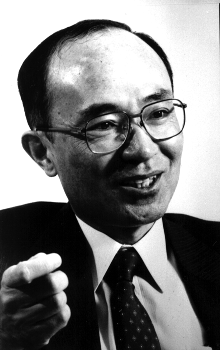
![[GlobalNews Home]](../globe.gif)
![[Prev Page]](/images/arrow-left.gif)
![[Next Page]](/images/arrow-right.gif)

The meaning of multi-media is not yet fully clear. Dr. Ikegami offered a working definition: "For the time being, it is a kind of networking among PCs and workstations." Most important is the personal computer (PC): "The PC is very versatile: it has a man-machine interface, a high performance computer, and, if you add a CD ROM, it has a very large memory. So everything is in this device. If we link these devices, we can offer many different kinds of services." NTT's responsibility is to provide the communications link, as well as to enhance useability and functionality.
Multi-media will require new hardware developments. "For instance, memory will be very significant. Large amounts of memory will be necessary for multimedia services. And also high speed devices are necessary, even at present. If we have a 10 Gbit/sec fiber optic system, for instance, can we obtain 10 Gbit from memory in a second? It will require very high speed processing between the memory and the communication channels."' Dr. Ikegami emphasized that hardware advances will continue to be one of the key elements in the implementation of multimedia, pointing out that multimedia terminals will require the advanced display (i.e., liquid crystal display) and memory technologies of Japanese manufacturers. The trend is demonstrated by Newton, a personal computing tool developed in the United States by Apple Computer and manufactured in Japan.
Software for multimedia will demand increasing attention. The multimedia
terminal of the future, connected to all parts of the world, will need new and
different types of software. Ikegami commented, "Research for hardware is
straightforward, but software is very different, and very difficult. It is a
kind of tool to realize some function desired by customers, and thus requires a
kind of feedback loop." This will require changes in the way research is done:
"... the production efficiency of software is very low. If resources are
limited, and if we have to emphasis the software area, then we have to reduce
hardware research."
NTT acknowledges that the best software development is done by software
developers in the United States, and recently signed collaborative research and
development agreements with Microsoft and several other prominent American
computer-related companies. "We believe at present that the origin of R&D
in multimedia will not be in Japan, will not be in the East Coast of the U.S.,
just in the West Coast. So we decided to touch upon some manufacturers in the
West Coast area", said Dr. Ikegami. Will NTT establish research labs in Silicon
Valley? "We have a West Coast NTT America office in Mountain View, California
and they are enlarging their space because many researchers and engineers from
NTT will join them. The people are on a mission of either collaboration or
technical alliance with Microsoft, Silicon Graphics, or General Magic. I would
like to send researchers or engineers having some mission. So it will look like
a multimedia laboratory, but not an independent laboratory." From these
beginnings, a stand-alone laboratory may emerge in the future.
The implications of these trends for international researchers at NTT are not
yet clear. Certainly, the most recent developments in communications, including
the emergence of multimedia, suggest a world that is increasingly without
boundaries. NTT's future, now almost entirely dependent on the domestic
situation in Japan, will become increasingly linked with developments in other
parts of the world. This could lead to increased demand for capable
international researchers, especially in the software development area. On the
other hand, if NTT's position as the major supplier of telecommunication
services in Japan is threatened or lost, either through failing to stay abreast
of technological changes, or because of political developments, NTT Labs would
be reduced in size. Nevertheless, demand for collaborations with foreign
researchers would continue if they continue to generate good results. "We
should be much more results-oriented. As for the basic research area, I will
never say business-oriented, since I know it doesn't make sense".
Before joining NTT in 1972, Dr. Ikegami lectured at Tokyo Institute of
Technology. At NTT, he did pioneering work on double-heterostructure DFB
lasers. He was Executive Manager of the Optoelectronics Laboratories from 1988
until 1991, when he accepted responsibilities as Deputy Senior Executive
Manager of NTT's R&D headquarters in Hibiya. He currently is Senior
Executive Manager of the NTT Science and Core Technology Laboratory Group and
Executive Director of NTT Basic Research Laboratories.

Dr. Tetsuhiko Ikegami
Dr. Tetsuhiko Ikegami personifies the trend towards increased
participation by NTT management in international aspects of science and
technology. He has been active for many years in international professional
organizations. This year (1994) he is president of IEEE Lasers and
Electro-Optics Society (LEOS) which represents laser and electro-optics
engineers and scientists around the world. LEOS publishes the IEEE Journal of
Quantum Electronics, the Journal of Lightwave Technology (jointly with the
Optical Society of America) and the Journal of Lightwave Technology. He has
been instrumental in bringing CLEO Pacific Rim, a new international conference,
to Japan next year. He also has been a pioneer in bringing international
postdocs and researchers to NTT Laboratories.
![[GlobalNews Home]](../globe.gif)
![[Prev Page]](/images/arrow-left.gif)
![[Next Page]](/images/arrow-right.gif)